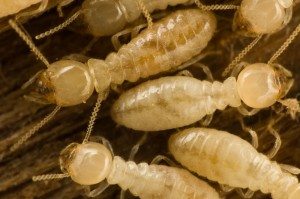How to Identify Termites
When you believe you have spotted termites in and around your house its can be a daunting experience, instantly fears of thousands of dollars or damage can come to mind. But can you really be sure that what you saw are termites? It’s all ways best to contact a professional termite expert to identify an infestation, as there are many species of termites and they all have different identifying features, so unless you are 100% sure that what you found is not termites its best to seek professional assistance.

The first step to identifying a termite is to catch the termite, if it is a winged insect capture them in a small jar or if it is wingless simply pick it up. Once the insect is caught, look for a broad waist and soft body. Whilst winged ants have a hard body and a narrow waist shape similar to a wasp, winged termites don’t have this narrow waist and don’t have a hard shell on their body.
termites don’t have this narrow waist and don’t have a hard shell on their body. If the insect still has its wings there are a couple of things to look for to help differentiate between ants and termites, ants have three distinctly separate body parts. There abdomen is separated into two distinct body parts by a slender waist, however termites will only have section on their abdomen and their head. With winged termites their two sets of wings are of equal size, as opposed to winged ants whose front wings are larger than the back. The other main identifying factor is the insect’s antennae, termites antennae are relatively straight and short, when compared to the bent or “elbowed” antennae of ants.
But not all termites have wings and you may have stumbled across a mud tube or a next in your house or yard, there are some easy ways to help you identify a worker or soldier termite from an ant. The same rules as with winged termites apply for non-winged termites when it comes to the abdomen, termites only have one abdomen section whilst ants have two. Worker termites are white and almost transparent in colouration, they look the most like traditional ants which is where they get the name “white ants” however they still follow the same rules in regards to number of abdomen sections and lack of bend in the antennae. Soldier Termites have much larger heads and large mandibles, their heads are often a darker orange or brown colour whilst still having a white body.
Identifying termites is difficult and requires years of training and experience. A skilled termite expert is able to identify termites in an instant as well as identify which specific species you have and what is the best way to treat them. Remember if you have any doubt as to if the insect you found are termites or not call a professional termite control expert to give you the peace of mind you need.
We found Complete Termite Solutions a pleaser to deal with and prompt and reliable service. The staff were friendly and helpful and we wouldn’t hesitate to recommend them to anyone.
Teresa & Mark Grier Dve
Heritage Park
